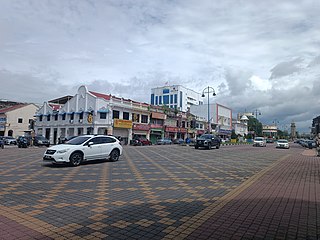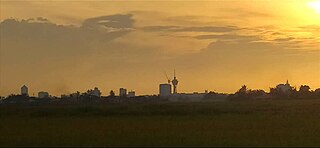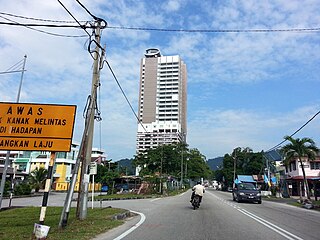The 8th century BC started the first day of 800 BC and ended the last day of 701 BC. The 8th century BC was a period of great change for several historically significant civilizations. In Egypt, the 23rd and 24th dynasties lead to rule from Kingdom of Kush in the 25th Dynasty. The Neo-Assyrian Empire reaches the peak of its power, conquering the Kingdom of Israel as well as nearby countries.

Kedah, also known by its honorific Darul Aman and historically as Queda, is a state of Malaysia, located in the northwestern part of Peninsular Malaysia. The state covers a total area of over 9,000 km2, and it consists of the mainland and the Langkawi islands. The mainland has a relatively flat terrain, which is used to grow rice, while Langkawi is an archipelago, most of which are uninhabited islands.

Universiti Sains Malaysia is a public research university in Malaysia. Founded on 1 June 1969 as a statutory body with its own constitution, it is among the oldest institutes of higher learning in Northern Malaysia. It has three campuses: a main campus on the island of Penang, a health campus in Kelantan, and an engineering campus in Nibong Tebal.

Sungai Petani is a city in Kuala Muda District, Kedah, Malaysia. Sungai Petani is Kedah's largest city and is located about 55 km south of Alor Setar, the capital of Kedah, and 33 km northeast of George Town, the capital city of the neighbouring state of Penang.

Alor Setar is the state capital of Kedah, Malaysia. It is the second-largest city in the state after Sungai Petani and one of the most-important cities on the west coast of Peninsular Malaysia. It is home to the third-tallest telecommunication tower in Malaysia, the Alor Setar Tower.

The Baling District is an administrative district in southeastern Kedah, Malaysia. Located about 110 km from Alor Setar, it borders Perak and Betong, the southernmost town of Thailand.

The Bujang Valley is a sprawling historical complex and has an area of approximately 224 square kilometres (86 sq mi) situated near Merbok, Kedah, between Gunung Jerai in the north and Muda River in the south. It is the richest archaeological area in Malaysia.

Seberang Perai is a city in the Malaysian state of Penang. It is situated on the Malay Peninsula opposite Penang Island, bordering Kedah to the north and east and Perak to the south. Its city centre is located in Butterworth, while its local authority, the Seberang Perai City Council, is centred near Bukit Mertajam. As of 2020, Seberang Perai had a population of 946,000, making it the third most populous city in Malaysia.

The Jeli District is a district and a parliamentary constituency in western Kelantan, Malaysia. As of 2010, the district's population is estimated to be 42,150. Jeli is administered by the Jeli District Council. Jeli is bordered by the state of Perak to the west, the Thai district of Waeng to the north, Tanah Merah district to the north east and Kuala Krai district to the south east.

The Kedah Sultanate is a Muslim dynasty located in the Malay Peninsula. It was originally an independent state, but became a British protectorate in 1909. Its monarchy was abolished after it was added to the Malayan Union but was restored and added to the Malayan Union's successor, the Federation of Malaya.

Merbok is a mukim in Kuala Muda District, Kedah, Malaysia. The historical Bujang Valley is located here. It is also the location for the Universiti Teknologi MARA Kedah Campus.

The Kuala Muda District is a district in Kedah, Malaysia. Sungai Petani is the administrative center of the district. Kuala Muda district is in close proximity to the border of Kedah and Penang. Apart from Sungai Petani, other major towns in the district include Tikam Batu, Padang Tembusu, Sungai Lalang, Bedong, Bukit Selambau, Sidam, Gurun, Semeling, Merbok, Kota Kuala Muda and Tanjung Dawai. The Mount Jerai is shared with the neighbouring district of Yan while the Muda River is shares the bordering state of Penang. The iconic Jambatan Merdeka connect both Tikam Batu with Bumbung Lima in Penang. Kuala Muda is the second largest and most populous district in Kedah, and it is also the site of some of the earliest civilization site in the country.

Gelugor is a suburb of George Town in the Malaysian state of Penang. Named after a plant species, Gelugor lies along the eastern seaboard of Penang Island, between Jelutong and Sungai Dua, and nearly 5 km (3.1 mi) south of the city centre.

By around 788 BCE, a large settlement had been established on the northern bank of the Merbok River. The settlement was one of several in the Bujang Valley, covering the Merbok and Muda Rivers, about 1000 square miles. The Merbok settlement was built near the estuary of the tributary river, the Sungai Batu. Around 170 CE groups of Hindu faith arrived at Kedah, joining them soon were peoples from nearby islands and from the northern Mon-Khmer region. At the same time traders from India, Persia and Arab, arrived the brink of the Malacca Strait, using Gunung Jerai the Kedah Peak as marking point. Ancient Kedah covered the areas of Kuala Kedah, Kuala Bara, Kuala Pila and Merpah.

Batu Uban is a residential neighbourhood within the city of George Town in the Malaysian state of Penang, about 6.7 km (4.2 mi) south of the city centre. Founded by ethnic Minangkabaus in the early 18th century, Batu Uban is regarded as the oldest Malay settlement on Penang Island.

Teluk Kumbar is a suburb of George Town within the Malaysian state of Penang. It is located about 17.8 km (11.1 mi) south of the city centre, at the southern coast of Penang Island between Bayan Lepas to the east and Gertak Sanggul to the west.

Kedahan Malays or commonly known as Orang Utara ('Northerners'), are a sub-group of Malays native to northern Malay Peninsula in areas of both current and historical area of Kedah. They are among the oldest ethnic groups in the Malay peninsula with a history dating back 2,800 years as proven by the discovery of sites in Bujang Valley and historical documents from India, China and Arabia. Kedahan Malays are one of the largest Malay sub-groups in Malaysia, comprising at least 15% of the total Malaysian Malay population including those with Kedahan ancestry.

Mamak stalls are indoor and open-air food establishments particularly found in Southeast Asia, especially in Malaysia and Singapore, which serve a type of Indian Malay Chinese cuisine unique to the region and community.
Kemondo Iron Age Sites or KM2 and KM3 are Early Iron Age complex industrial archaeological sites in Kemondo ward, Bukoba Rural District, Kagera Region, Tanzania, excavated by a team led by archaeologist Peter Schmid in the late 1970s and 1980s. The excavations aimed at better understanding the iron smelting process and its ritual aspects in East Africa. At the KM2 and KM3 sites, Schmidt tested the hypothesis that the high combustion temperature of furnaces, discovered to be between 1,350–1,400 °C (2,460–2,550 °F), was caused by the preheating of air blasts. Preheating has been suggested to be a distinct feature of African Early Iron Age smelting techniques by ethnographic observations of the Haya people of northwestern Tanzania.

Batu Uban is a state constituency in Penang, Malaysia, that has been represented in the Penang State Legislative Assembly since 1986. It covers a portion of Penang Island's eastern seaboard, including the southernmost suburbs of George Town.
























